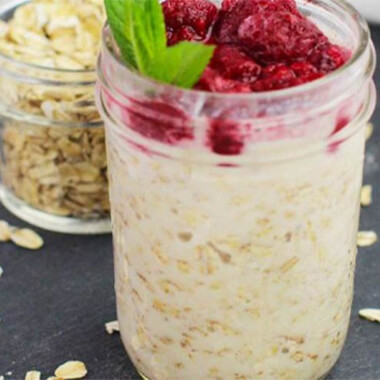Got Milk?
FEATURED RECIPES
Overnight Oatmeal + Berries

Just mix the night before and refrigerate overnight. You’ll have a quick & portable breakfast in the morning.
Ingredients
- 1/2 cup low-fat milk
- 1/3 cup Greek yogurt, fat free
- 2 tsp honey
- 1/4 tsp cinnamon
- 1/4 tsp vanilla extract
- 1/2 cup uncooked rolled oats
- 1/4 cup raspberries, frozen
Instructions
- Combine milk, yogurt, honey, cinnamon, and vanilla in a container with a lid.
- Add oats and mix well.
- Gently fold in raspberries.
- Cover and refrigerate 8 hours, up to overnight.
- Enjoy cold or heat to serve.
Peach Cooler

On a hot summer day, freeze drained canned peaches (or fresh) for at least 45 minutes prior to preparing this sweet & tangy treat.
Ingredients
- 2 cups milk, 1% low fat
- 1 cup peaches
- 1/2 tsp lemon juices
- Dash of nutmeg (optional)
Instructions
- Put the ingredients in the blender.
- Blend well.
- Sprinkle with nutmeg if desire.
- Serve cold.
Click here for complete recipe
Click here to find other recipes featuring low fat & fat free dairy.
GOT MILK?
Historical Perspective
For more than 100 years, milk has been the basis of a healthy diet. Beginning in 1916 with the government pamphlet Food for Young Children, milk was one of the 5 food groups necessary for growing children. Milk was included in the 1943 National Wartime Nutrition Guide, otherwise known as the Basic Seven. Food guidance policy continued to evolve (Basic 4 1956, Food Guide Pyramid 1984, My Plate 2005) with milk maintaining a firm position in a balanced diet. Even the most current release U.S. Dietary Guidelines for Healthy Americans touts the benefits of milk consumption for health promotion. Again, the 2015–2020 Dietary Guidelines for Americans recommends that people consume three servings of dairy every day to meet their calcium needs.
Milk is an original farm-to-table food. An increasing number of consumers are choosing Non-Dairy Milk Alternatives (NDMA) for their morning lattes or to pour on cereal.
Grocery store dairy cases are certainly witness to changing consumer preferences. There are so many options beyond whole, 2% and skim. More space is now dedicated to NDMA than dairy milk.
Full disclosure here: while I am not a dairy farmer nor is anyone in my family, I am eating cereal with real milk as I write this. I am a dairy girl all-the-way! I also realize that you may be someone who does not share my enthusiasm for dairy, but you may rethink your drink after seeing some facts.
Alternate Causes
The most obvious reason a consumer may choose a NDMA over cow’s milk is the presence of allergy to the protein’s whey or casein, or both. (This is not to be confused with lactose intolerance or A1 protein intolerance. There are dairy formulations on the market to deal with these conditions.) Milk allergy affects about 3% of children in the U.S. under the age of 3 years, and most outgrow it by middle school. Lactose intolerance, on the other hand, is life-long and affects close to 75% of the world’s population. Some of those afflicted can often ingest some lactose without consequences.
Other reasons for dairy avoidance include: 1) conflict with dietary restrictions in Crohn’s disease or Low FODMAP, or lifestyle choices such as vegan; 2) concern for potential health risks related to antibiotic residues, pesticides, or hormones; 3) taste preferences, 4) sustainability.
As for A1 protein intolerance, this is a relative newcomer on the scene of gastrointestinal disturbance with symptoms that mimic lactose intolerance. I have had clients with complaints of “lactose” intolerance with no improvement on a lactose-free diet. Data on actual prevalence is lacking and may be related to the similarities of symptoms. It has been suggested that the A1 protein may be the source for inflammation that has been routinely associated with cow’s milk.
Nutritional Comparison
When cow’s milk is fortified with vitamin D it is a source of 14 nutrients. Even skim milk contains 7 nutrients at levels greater than 10% daily value: protein, calcium, phosphorus, and vitamins B12, niacin, riboflavin, pantothenic acid. Eight if you include the added vitamin D. Unfortified soy milk has only 2 nutrients at levels greater than 10% daily value: protein and calcium. Unfortified almond, coconut and cashew milks have none.
While nuts are nutrient powerhouses, nut pulp is strained out in the manufacturing process and the fiber, protein, vitamins, and minerals are lost. And carrageenan and vegetable gums are added to give the beverage a smooth texture.
The nutritional profile of each type of “milk” depends not only on the plant source, but also the manufacturing process and the degree of fortification. These factors are especially important when considering the protein, vitamins, minerals, and sugar in each serving. Most non-dairy milk alternatives are fortified to provide a reasonable amount of calcium and vitamin D, although amounts of other micronutrients are often unknown. The body can absorb about 30–32% of the calcium in dairy products, and only 20–30% of the calcium from plants sources such as almonds.
Besides taste and texture, protein and added sugars are perhaps the most widely variable attributes among plant-based milks.
The Nutrition Facts panel will show you what nutrients have been fortified, and the ingredient list will alert you to added flavors or sweeteners.
The American Academy of Pediatrics recommends that children between ages 1 and 2 consume whole cow’s milk. Substituting a plant-based milk for animal-based dairy products in babies and young children could lead to nutritional deficiencies.
Other factors that may be important to you:
- Environmental sustainability is a concern in almond production, since 80% of almonds are produced in California, which faces drought issues.
- Oat milk contains more calories and carbohydrates than other alternatives.
- 94% of all soybeans in the US are genetically engineered.
- Coconut milk is considered by some to be environmentally problematic because of emissions related to its production in India and Asia and shipping across the globe.
- Rice milk is a potential source of arsenic and caution is recommended when considering as a beverage for children.
| 1% milk | Soy | Almond | Cashew | Coconut | Rice | Hemp | Oat | |
|---|---|---|---|---|---|---|---|---|
| Calories | 102 | 80 | 35 | 50 | 45 | 70 | 60 | 60 |
| Protein (g) | 8 | 7 | 1 | 1 | 0 | 0 | 3 | 1 |
| Fat (g) | 1.5 | 4 | 2 | 2 | 4 | 2 | 4 | 2.55 |
| Calcium (mg)** | 305 | 300 | 430 | 44 | 130 | 325 | 263 | 460 |
| Potassium (mg) | 366 | 350 | 35 | 150 | 310 | 50 | 100 | 170 |
| Vit D (mcg)** | 2.9 | 3 | 2 | 2 | 2 | 6.8 | 2 | 3 |
| Vit A (mcg)** | 140 | 150 | 140 | 140 | 180 | 160 | 0 | 150 |
* All portions are 8oz and plain/unsweetened.
** Nutrients that are likely to be fortified in plant-based milks
And lastly, deep in the Code of Federal Regulations Title 21 of the Food and Drug Administration (FDA)is the definition for the legal term milk: milk is the lacteal secretion, practically free from colostrum, obtained by the complete milking of one or more healthy cows. Milk that is in final package form for beverage use shall have been pasteurized or ultra pasteurized and shall contain not less than 8 1/4 percent milk solids not fat and not less than 3 1/4 percent milk fat. Milk may have been adjusted by separating part of the milk fat therefrom, or by adding thereto cream, concentrated milk, dry whole milk, skim milk, concentrated skim milk, or nonfat dry milk. Milk may be homogenized.”
The American Dairy industry has been demanding enforcement of this standard since 2010. The Court of Justice of the European Union in Luxembourg in 2017 announced purely plant-based products cannot, in principle, be marketed with designations such as ‘milk’, ‘cream’, ‘butter’, ‘cheese’ or ‘yogurt’, which are reserved by EU law for animal products.
Conclusion
When choosing a NDMA beverage for your family, do your homework and ignore the hype.
- Focus on fortified.
- Choose unsweetened.
- Be aware of additives.
- For a growing child only fortified soy milk is an ok alternative.
Selected Sources & Further Reading
- Bridges M. “Moo-ove Over, Cow’s Milk: The Rise of Plant-Based Dairy Alternatives,” Practical Issues in Gastroenterology (Jan 2018): Nutrition Issues in Gastroenterology. https://med.virginia.edu/ginutrition/wp-content/uploads/sites/199/2014/06/January-18-Milk-Alternatives.pdf
- Centers for Disease Control and Prevention. “Cow’s Milk and Milk Alternatives.” (2022, May 20) https://www.cdc.gov/nutrition/infantandtoddlernutrition/foods-and-drinks/cows-milk-and-milk-alternatives.html
- Torborg L. “Mayo Clinic Q and A: Dairy milk, soy milk, almond milk – which is the healthiest choice for you?” (2019, April 9) https://newsnetwork.mayoclinic.org/discussion/mayo-clinic-q-and-a-dairy-milk-soy-milk-almond-milk-which-is-the-healthiest-choice-for-you/
- Walther B. et. al. “Comparison of nutritional composition between plant-based drinks and cow’s milk. Front Nutr. 2022 Oct 28;9:988707
Published: April 2024


Comments